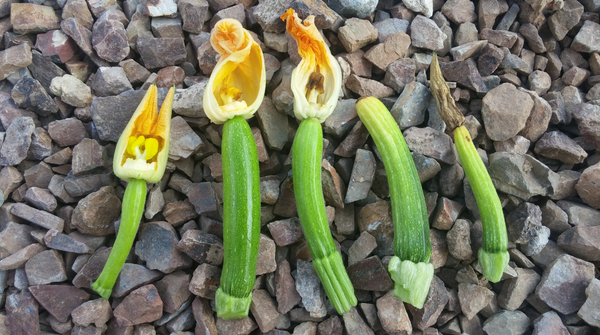
By Melissa Kruse-Peeples, NS/S Education Coordinator. Originally published July 25, 2014. Updated May 16, 2017.
One of the most common gardening problems from those growing squash, cucumbers, or watermelons is the abundance of baby fruits, but none that grow to full size. The baby fruits shrivel and wither away. The most common reason for this is that the fruits were not pollinated and therefore not fertilized to develop into a mature fruit. In this blog post we share information about how cucurbits are pollinated and provide instructions for hand pollinating squash that can be applied to other species in this plant family.
Fruits of the Cucurbitaceae family, or cucurbits, require pollen from male flowers to reach the female flowers to fertilize the fruit. They are monoecious plants and while there are separate male and female flowers, both occur on the same plant. Cucurbits include all squash varieties like zucchini or pumpkins (Cucurbita pepo) and butternut squash (Cucurbita moschata) as well as cucumbers (Cucumis sativus), watermelons (Citrullus lanatus), melons (Cucumis melo), and gourds (Lagenaria siceraria).
The observation of “baby fruits” is more appropriately described as the presence of unfertilized ovaries. Bees are primarily responsible for the movement of male pollen to female flowers so if you lack bees, then you will lack developing fruit. The best advice to produce fertilized fruit is to attract a healthy population of pollinators to your garden by planting flowers and by using organic gardening methods. Particularly in some urban areas, honey bees can be hard to come by but there are hundreds of native bee species and we can all play a role in preserving these tiny creatures essential for healthy ecosystems. If your local bees are playing hide and seek with your garden crops you can also practice hand pollination to produce fertilized fruits.

Female flower with ovary at the base (left) and male flower (right).

Bees on the male flower stamen.
Below are instructions for hand pollinating squash. Detailed instructions can also be found in Saving Seeds in the Southwest published by Native Seeds/SEARCH. Similar procedures can be used for cucumbers, melons, and watermelons but the smaller size of the flowers requires delicate hands. Q-tips or small paintbrushes work well for the species with smaller flowers. For large flowered squashes avoid the extra waste and use the stamen of the male flower as the brush. Cucurbit flowers only open for one day so picking the male flowers to use in hand pollination will not limit the future pollination potential. Complete your hand-pollination activities in the morning when the pollen on the male flower is most viable. The pollen will have detached and fallen to the bottom of the flower making it harder to recover and as it becomes warmer the pollen becomes sterile. Use several male flowers per female flower to increase the chances that the pollination will “take” and set fruit.
The male flowers have the stamens and the female flowers contain the pistils, whereas in self-pollinating plants like tomatoes or beans the stamens and pistils are contained within the same flower which does not require pollinators to move pollen between flowers. Because they contain different reproductive parts, male and female flowers are easy to distinguish by examining the interior of the flower and the stem just below the flower. Female flowers will have an ovary, which looks like a small fruit developing at the base of the flower. This feature is absent in the male flowers. The pistils inside the female flower has multiple lobes whereas the male stigma will look like a single lobe which are the fused anthers and filaments. Male flowers will typically be much more abundant than female flowers. They also bloom earlier, an evolutionary strategy to attract the pollinators for when the female flowers bloom. (See banner photo - male flower on the left, female on the right.)
If the female flowers are pollinated and the fruits fertilized, the ovary at the base of the flower will begin to swell and grow. The pistil inside the flower will turn black and begin to shrivel. If the female flower has opened and no pollination has occurred, the ovary will being to turn yellow and shrivel. If you notice that the female ovaries are yellowing then it is a good idea to make hand pollination a daily routine.

From Left to Right: Developing female flower, not yet opened; Female flower that has had successful pollination likely the day before, ovary beginning to swell; female flower that has had successful pollination, pistil darkening; female flowers that were unsuccessfully pollinated and fertilized, yellowing and shriveling.
Female flowers can be fertilized by pollen from male flowers from the same plant as well as from the male flowers of other plants of the same species. Therefore, if you grow more than one variety of the same species in your garden, for example two different types of cucumbers, there is a high probability that cross-pollination will occur. This usually does not have any influence on the first generation of fruits produced and what you eat for dinner but it will influence the seeds saved from those fruits. Practicing hand pollination is necessary if you wish to grow more than one variety of a curcubit species and save seeds (see step 3 below). Otherwise it is likely that the seeds saved will produce off-type fruit that will not resemble the parent variety. Even if you only have one variety growing it is possibly that your neighbor’s varieties will cross-pollinate with your garden. It is recommended that varieties of the same species be planted 800 to 1600 feet apart. Therefore if you are serious about saving true-to-type seeds you should practice hand pollination. Mark your hand-pollinated fruits with flagging tape or a piece of string to remember which were hand pollinated.

Click to download a printable version of out hand pollination handout here or a Spanish version here.
